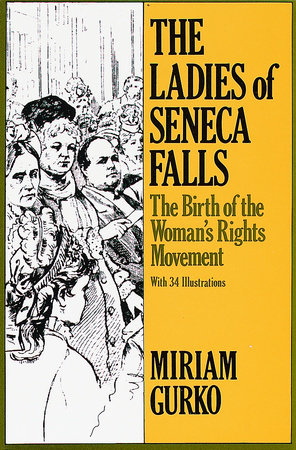Who were the ladies of Seneca Falls? Originally there were five: five ladies sitting around a tea table in 1848 in the small town of Waterloo in upstate New York. Four of them, the Quaker preacher Lucretia Mott of Philadelphia, his sister Martha Wright, Jane Hunt, and Mary Ann McClintock, listened while the fifth, Elizabeth Cady Stanton of nearby Seneca Falls, suddenly began to pour out her “discontent . . . with woman’s position as wife, mother, housekeeper.”
Until the previous year, Mrs. Stanton had led a highly stimulating life. As the wife of Henry Stanton, the abolitionist orator, she had attended the turbulent World Anti-Slavery Convention in London—where she first met Lucretia Mott—visited Paris, then settled in Boston in one of the richest periods of that city’s history.
It was a time of great reform movements—the abolition of slavery, temperance, religious agitation, campaigns to eliminate war—in which the Stantons took a leading part. They had three sons, but with a comfortable house and good servants, domestic life ran smoothly and she was free to enjoy the exhilarations of Boston.
It wasn’t until they had to leave the city because of Henry Stanton’s health and move to Seneca Falls in 1847 that Elizabeth Stanton began to live more like the average housewife. Their house was older, less convenient, and harder to run than their Boston house; she found it impossible to get good servants. Above all, she missed the intellectual activity and companionship she had enjoyed in Boston. Henry Stanton was often away on business, and she was left along with just the children. The dimensions of her life quickly shrank to painfully narrow limits.
By the time she went to Waterloo for a reunion with Lucretia Mott, her dissatisfactions had become so acute that, over the teacups, she found herself releasing “the torrent of my long-accumulating discontent, with such vehemence and indignation that I stirred myself, as well as the rest of the party, to do and dare anything.”
What they dared—and in those days it took monumental daring—was to call a woman’s rights convention. The possibility of such a convention had occurred to Mrs. Mott and Mrs. Stanton at their first meeting eight years before, but nothing had come of it. Now, however, they and the other ladies took action. That evening they wrote an announcement which appeared the next day, July 14, 1848, in the
Seneca County Courier. It invited women to attend “A Convention to discuss the social, civil, and religious condition and rights of woman” in the Wesleyan Chapel at Seneca Falls on the 19th and 20th of July.
***
They had no idea of how to organize such a meeting, or what the outcome would be. It was the first time in history that women had ever done anything remotely like it. Yet from this almost offhand, accidental beginning would arise the dynamic woman’s rights and suffrage movements in the United States, and these would in turn inspire similar movements in other parts of the world.
In a sense the convention could be said to have arisen spontaneously from Elizabeth Stanton’s discontent, but even with Mrs. Stanton it wasn’t quite that spontaneous. Her early life, her experience at the London Anti-Slavery Convention, her observations and awareness of “the wearied, anxious look of the majority of women,” topped by her own personal frustrations, had all led to this moment. “It seemed as if all the elements had conspired to impel me to some onward step.”
But individuals, even as fiercely independent and forceful as Elizabeth Stanton, do not act in a historical vacuum. A long series of earlier events and stirrings helped establish a foundation for such a convention. The year itself, 1848, known as the “year of revolutions,” contributed its impetus. And though Mrs. Stanton’s complaints seemed relatively simple—too much domestic drudgery and too little mental activity, too much isolation and too little adult companionship—the problem was far more complex. Mrs. Stanton herself would explore not only the legal and social bases of her discontent, but the subtle psychological fogs through which women had to grope before understanding themselves and their relationship to the world.
Indeed, defining the problem was in some ways as difficult as solving it. What, after all, was wrong with the way women lived, as distinguished from all the things that might be wrong with the world as a whole? What, after all, did women really want?
Copyright © 1987 by Miriam Gurko. All rights reserved. No part of this excerpt may be reproduced or reprinted without permission in writing from the publisher.




